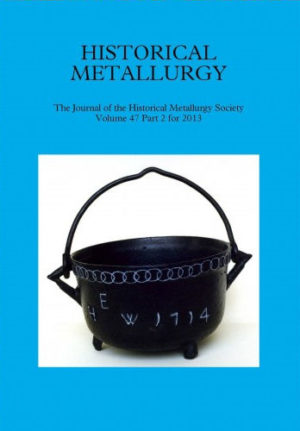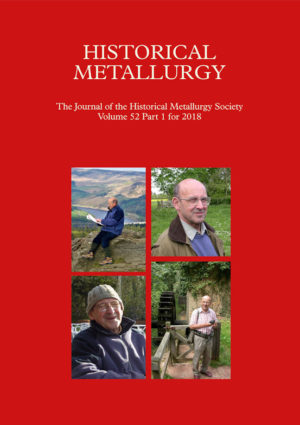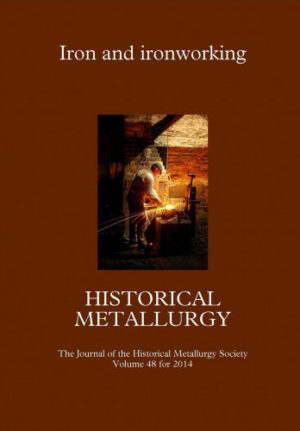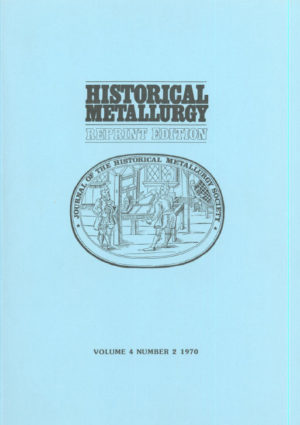Journal Contents
Determinative mineralogy in the early development of metals
J A Charles
Pages 66-68
The characteristics of minerals in terms of natural colour, density, texture, flame colour, smell on heating and streak colour are used to suggest a basis for the way in which minerals could have been selected for metal recovery and how, thus, alloy usage may have developed in prehistory.
Recent progress in the study of early mining and metallurgy in the British Isles
Paul T Craddock
Pages 69-83
This paper summarises some of the progress made in the study of non-ferrous mining and extractive metallurgy in the British Isles in prehistory during the last five years since the publication of the proceediags of the Plas Tan y Bwlch conference (Crew and Crew 1990) up to the conference on Bronze Age Copper Mining held at Bangor on the 15th-18th of September 1995, organised jointly by the British Museum and the Early Mines Research Group. Despite very real advances, there still remain significant lacunae in all aspects of our comprehension of this still new area of prehistoric investigation.
Sweat, Fire and Brimstone: Pre-treatment of copper ore and the effects on smelting techniques
Roger C P Doonan
Pages 84-97
Full scale experimental reconstruction of beneficiation and roasting techniques based on evidence from a Bronze Age context in the eastern Alps suggests that these techniques are important in considering subsequent smelting technology. Results are based on the consideration of chemical analyses of ore samples at various stages of preparation prior to smelting. Implications for early discovery mechanisms are also considered in light of the evidence presented in this study.
Untangling the web: some new views on the origins of prehistoric metallurgy
P Budd, B Scaife, T Taylor and R G Thomas
Pages 98-103
Developments in early metallurgy have often been seenas innovative responses to fluctuations in the availability of raw materials. In this progressive framework the production and circulation of metal is explained in terms of supply and demand utilising concepts borrowed from modem economics. This idea of Bronze Age metallurgy as an economic activity utilising technological advances to supply a market is now considered inappropriate. This paper uses the specific case study of the &st use of sulphide ore sources in the central European Bronze Age to highlight some of the difficulties inherent in such deterministic models of metallurgical development.
The metalwork from Flag Fen
B M Rohl and J P Northover
Pages 103-111
115 analyses were made from metal objects from the Bronze and Iron Ages at Hag Fen. Firstly this was to identify the metals and alloys used and then, using the robust chronology now existing for Bronze Age compositions, to assign many of the objects to a period where this was not possible on typological grounds. The results are used to show how the use of metal on the site reflects the intensity of other activity there. Lead isotope analyses were also made on many of the objects sampled and the results support the picture of the metalwork built up on the basis of composition and typology. Special attention is paid to the tin and tin-lead alloy objects and their nearest parallels from Swiss Lake sites.
Bronze casting experiments
Tristan Bareham
Pages 112-116
This paper describes the bronze casting experiments carried out by the East Sussex Archaeology and Museums Project (ESAMP) during the HMS meeting at Flag Fen on 21st-22nd May 1994. Five castings were made on the 22nd and these are examined. Further reference is made to other casting experiments earned out by ESAMP and the paper also looks at some relevant areas of experimental development.
Tin from the Bronze Age smelting viewpoint
Bryan Earl
Pages 117-120
The problems associated with the discovery of tin ore, its separation and smelting to metal are discussed. Probable Anatolian Bronze Age techniques are examined with reference to later, AD period, British practice.
An experimental tin smelt at Flag Fen
Simon Timberlake
Pages 121-
Experimental bowl and shaft furjiaces were constructed. Tin ore was smelted in the bowl furnace using bag bellows to supply the air. The process was relatively quick and simple to operate. Tin metal that was 99% pure was produced, with a yield of about 50%.
![[Test] The Historical Metallurgy Society](https://test.historicalmetallurgy.org/wp-content/uploads/2020/02/Logo120.png)





There are no reviews yet.